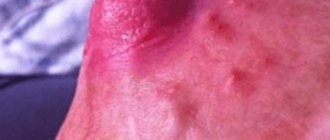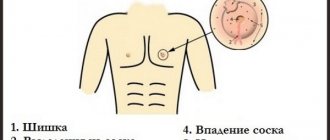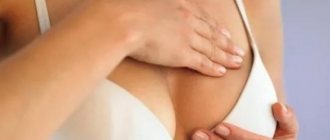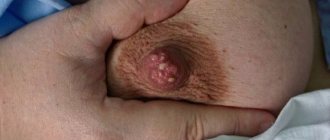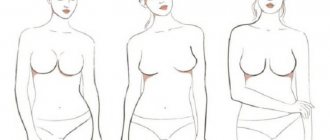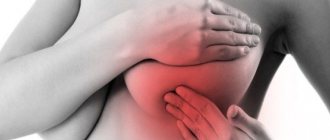- Etiology
- Classification
- Symptoms
- Diagnostics
- Treatment
- Prevention and prognosis
Pain in the mammary glands is a nonspecific symptom that every person has encountered at least once in their life. Contrary to erroneous belief, this symptom is characteristic not only of females, it is also often found in men.
Often, such a manifestation is associated with the course of a disease that negatively affects the mammary gland; in particular, it may indicate the formation of a malignant tumor. However, in some cases, such pain is quite normal.
Most often, rather specific symptoms develop against the background of the main symptom, in particular swelling and swelling of the affected gland, redness of the skin and the appearance of easily palpable lumps.
If such an alarming sign occurs, you should seek help from a mammologist, who, in addition to a thorough physical examination, will prescribe several laboratory and instrumental examinations.
Pain in the mammary gland when pressed is eliminated using conservative methods, however, to completely get rid of this symptom, it is necessary to cure the underlying disease.
Pain due to breast pathology
Pain in the mammary glands, scientifically known as mastalgia, is a common condition. In fact, up to 70% of women experience breast pain at some point in their lives. However, there are several causes of this problem that require medical attention.
To make it easier to understand why breasts hurt, let's look at the possible causes, dividing them into two categories: those that are directly related to the mammary gland and those that are localized outside the organ.
Natural hormonal cycles and local infection are the main causes of pain associated directly with the mammary gland.
Cyclic mastalgia
If your doctor determines that your problem is just chest pain and nothing more, this is called mastalgia . One type of this pain is cyclic mastalgia.
The appearance of cyclic pain is caused by the menstrual cycle. Therefore, in response to hormonal fluctuations, there should also be an increase and decrease in the mammary glands. Cyclic mastalgia is characterized by dull, severe pain in both mammary glands. As a rule, it is diffuse (the whole chest hurts). Possible pain in the armpit area.
Due to the fact that this pain is directly related to menstruation, it most often occurs in premenopause. In postmenopause, non-cyclic mastalgia is usually recorded.
Noncyclic mastalgia
Non-cyclic pain may be felt in, under or near the chest. Usually this is an acute or burning pain that is diffuse in nature. There may be cases where it is localized in a specific area of the mammary gland. This is usually the result of hormonal changes caused by medications. For example, such as oral contraceptives, fertility drugs, hormone replacement therapy drugs.
The cause of non-cyclic mastalgia may be obesity, which is caused by breast enlargement. This problem usually occurs in women with large breasts who wear an incorrectly fitted bra, which leads to sprained Cooper's ligaments. They are a kind of frame for the mammary gland.
Finally, there is evidence, although not fully confirmed, that certain lifestyle factors can contribute to the appearance and cause non-cyclical mastalgia. These include: caffeine, smoking, high-fat diet.
Fibrocystic changes in the breast
Fibrocystic mastopathy (fibrocystic mastopathy, fibrocystic breast changes) is a benign disease of the mammary glands, during which normal glandular tissue is replaced by dense fibrous tissue, as well as the formation of cysts. Painful “lumps and lumps” appear in one or both breasts.
Fibrosis is the proliferation of connective tissue. In other words, a patch of scar tissue appears in the mammary gland - small millet-like nodules and cords are formed that can be felt.
A cyst is a capsule in the mammary gland that contains fluid; it is a soft formation with smooth edges to the touch. Breast cysts most often occur in women aged 30-40 years (they are also detected in men).
Pain in the mammary gland with fibrocystic mastopathy usually intensifies before menstruation.
Breast injury
The mammary gland is covered with sensitive skin, which protects its tissue, which contains many nerves and blood vessels. If you have had a chest injury (for example, during a car accident), the aching pain will bother you until the bruising heals.
Sometimes after an injury, scar tissue forms in the area of the injury, which can cause pain. The condition is called fat necrosis of the breast. To the touch, such a formation is usually hard, fused with the surrounding tissues, and resembles a malignant tumor of the mammary gland.
Find out more: How to distinguish a benign breast formation from a malignant one?
Breast surgery
After any surgery, be it breast augmentation (or breast augmentation ) or breast reduction or reconstruction, your breasts will hurt until the incisions heal.
Pathology of the milk duct
Several benign but painful conditions can develop within the breast duct system. For example, the milk ducts (which men also have) may become blocked. The associated infection causes inflammation, which causes pain. Mastitis (breast infection) develops
The sensation of tingling and fullness is accompanied by soreness of the mammary gland. In severe cases of the disease, the chest swells, fever and general malaise appear. If mastitis is not treated, it can be complicated by the formation of a breast abscess (accumulation of pus).
The most common are so-called lactation mastitis (in pregnant and breastfeeding women. Mastitis not associated with lactation is called non-lactation mastitis.
Another possible problem associated with the ductal system is milk duct ectasia (or mammary ductectasia). This condition (rarely found in men) is characterized by the fact that the excretory ducts located immediately behind the nipple widen and their walls thicken, which leads to blockage and accumulation of fluid in the resulting cavities.
In addition to soreness and redness in the nipple area, ductectasia is characterized by a discharge from the breast, which is usually yellow or gray in color. If scar tissue forms around the affected duct, this is accompanied by the appearance of a palpable formation in the area of the nipple-areolar complex.
Mammary cancer
Breast pain can be a symptom of breast cancer, although it is extremely rare. One study found that less than 10% of women diagnosed with breast cancer experienced breast pain.
One of the aggressive, fortunately rare forms of edematous-infiltrative breast cancer (or inflammatory cancer) usually begins with pain. In addition, this type of cancer is characterized by redness of the skin and swelling, while, as a rule, a tumor-like formation in the mammary gland is not detected.
Related article: Mastitis and inflammatory breast cancer
Gynecomastia (men only)
In most cases, painful discomfort in the breast or nipple in men is caused by gynecomastia. This condition is characterized by the proliferation of glandular tissue of the mammary gland. As a rule, gynecomastia is the result of a hormonal imbalance, more precisely, an increase in estrogen levels and/or a decrease in androgen production).
Why does my right breast hurt?
Women who are attentive to their health most often turn to a mammologist with complaints of pain in the right mammary gland, which occurs for the following reasons:
- Menstrual syndrome. As a rule, a week to a week and a half before the start of menstruation, women experience a dull, sometimes aching pain. Quite often it manifests itself in only one mammary gland – the right one. In this case, the breasts may swell, increase in size unnaturally and even become rough. In medicine, this phenomenon is usually called mastodynia. It occurs due to hormonal imbalance, which inevitably occurs during the premenstrual and menstrual periods. Does not require urgent medical attention.
- Mastopathy. This type of disease is characterized by the proliferation of glandular tissue, and it often happens that it appears only on the right side of the chest. As statistics show, mastopathy most often affects girls who are just entering their reproductive years and are emerging as women. If the breast on the right hurts due to mastopathy, then the doctor will most likely prescribe you to maintain a healthy lifestyle and a normal diet.
- Fibroma or fibroadenoma. A tumor in the right breast, diagnosed as fibroadenoma, is quite often the main cause of acute pain. In this case, the lump in the breast will be so obvious that every girl can conduct a self-examination and detect a fibroid. Of course, the presence of any changes in the normal shape and appearance of the breast requires a professional examination.
Suppuration of atheroma. If you feel a sharp pain in the chest on the right, and it comes and goes, then most likely the situation is as follows: a cavity forms in the mammary gland, which is filled with fat. Please note that if the same cavity is filled with water, this will provoke the formation of a cyst.
- Fat necrosis. Pain on the right side of the chest can also occur due to old injuries or a minor blow. Women's breasts are sensitive, and blood vessels can be damaged even by the slightest external influence. They also provoke the formation of fat necrosis. The disease can be diagnosed only after an initial examination.
All of the above reasons, although they can cause discomfort in the chest, are still not very dangerous and, moreover, are easily treatable.
The main thing is to understand that lumps, tumors and pain in the breast on the right are unlikely to go away on their own (with the exception of menstrual syndrome), so it is not recommended to delay contacting a mammologist.
Pain in the mammary gland, the cause of which is outside the organ
Costochondritis
Costochondritis (or costosternal syndrome) is an inflammation of the cartilage of the chest wall. It is the most common cause of chest pain. Pain may be felt in the breast area. The pain usually intensifies with movement or changing body position. The disease is more common in women after 40 years of age.
Chest trauma
If you lift something heavy unsuccessfully or pull a muscle during exercise, all this can cause pain in the mammary gland. It usually increases with breathing, coughing, talking, moving and decreases with rest.
Muscle spasm
Below the mammary glands are the muscles of the chest. Myositis of the chest is an inflammatory disease that affects the muscles of the same name. Myositis causes a lot of pain, including pain in the breasts, as there is muscle spasm. The condition may last only a few minutes or several days. This disease is more common in women aged fifty and older.
Spinal disease
Degenerative changes in the intervertebral discs can sometimes cause chest pain. The pain is most often felt or aggravated by movements such as sitting, bending, lifting, and twisting.
Fibromyalgia
Fibromyalgia is a condition characterized by chronic, widespread pain. Pain in the breast is not uncommon with this pathology. In addition to pain, other symptoms may occur, which is why the term fibromyalgia syndrome (FMS) is used. Other manifestations of the syndrome: a feeling of fatigue, which leads to disruption of vital functions, sleep disturbances and a functional decrease in joint mobility.
Lung diseases
Some lung diseases may be accompanied by pain in the mammary gland. Two examples:
- Pneumonia
- Pulmonary embolism
Myocardial infarction
What feels like chest pain may be a sign of a heart attack. The main clinical signs of myocardial infarction:
- Intense chest pain
- Pain in the neck, jaw, or left arm
- Dyspnea
- Sweating
- Nausea
- Dizziness or fainting
Symptoms of a heart attack in women Please note that women often do not have significant chest pain, but instead have pain in the neck, arm, breast, or a feeling of fatigue. Women often ignore these symptoms, not paying attention to painful discomfort, which manifests itself as cyclical or non-cyclical pain in the mammary gland.
Problems with the esophagus
Gastroesophageal reflux disease is the most common disease of the esophagus; and is characterized by the presence of both esophageal and extraesophageal manifestations of the disease. One of the signs of this disease may be a feeling of chest pain.
Other diseases of the digestive system can also cause pain that feels like it is coming from the chest or shoulder area (for example, gallbladder disease, which is localized on the right side).
Shingles
Herpes zoster (synonym: herpes zoster) is a viral disease characterized by unilateral herpetiform skin rashes with severe pain. The disease of viral etiology most often affects people over 70 years of age. With herpes zoster, pain sometimes precedes the appearance of the rash.
Prevention of pain in the right chest
Most diseases, including those that are somehow related to the mammary glands, can be prevented. Women and men who do not turn a blind eye to the fact that they have chest pain can detect the causes of discomfort in the early stages. This means that treatment will take place in more pleasant conditions.
Take the following tips as a rule and then you will be able to prevent most diseases that are in one way or another related to the chest:
Women are strongly advised to regularly palpate their own mammary glands. The chest of men is less sensitive, but, nevertheless, should also be monitored, since pain on the right side often occurs in them.
- Protect your own chest when falling, from sudden shocks and blows. A little damage to blood vessels, and now you are the unlucky owner of a hematoma or compaction.
- Women should choose the right underwear that does not compress the breasts.
- The feeding period should not be centered around the right breast alone; constantly alternate it with the left.
- Lead a healthy lifestyle, watch your diet.
- Control your weight. Excess weight in the chest area can also cause pain.
When to see a doctor
If you experience breast or nipple pain, be sure to consult a specialist: either see a primary care doctor or a gynecologist. Despite the fact that in most cases, breast pain is not intense and can be easily managed, do not put off visiting a doctor. Since this can delay the timely diagnosis of diseases such as breast cancer and cardiac pathology.
In addition to pain, the following breast changes require medical evaluation:
- Swelling of the breast, even if the mass cannot be felt
- Skin changes such as redness, peeling, thickening and retraction
- Discharge from the nipples (if it is not lactation)
- Enlarged lymph nodes, especially those located near the collarbone and in the armpit area
Find out more: Breast Cancer Symptoms Women Often Overlook
Etiology
Pain in the breast area can occur in absolutely every person, regardless of gender. As for children, such a manifestation is rare for this age category.
It is noteworthy that in men and women both the same and individual predisposing factors can cause such an alarming signal.
For example, in female representatives, pain develops against the background of:
- hormonal changes in the body, which may be associated with the formation of menstrual function or with the period of bearing a child. It is worth noting that pain can occur both in early and late stages of pregnancy;
- infertility therapy, which is often carried out with medications, less often with surgery;
- uncontrolled use of certain groups of medications, in particular oral contraceptives or antidepressants;
- premenstrual syndrome - in such cases, the appearance of pain in girls and women, if they are not accompanied by other symptoms, is quite normal. If the pain disappears with the onset of menstruation, then there is no need to see a doctor;
- menopause - pain in the mammary gland during menopause is also not uncommon and, without the expression of other symptoms, has no pathological basis;
- cystic or cancerous neoplasms - in such cases, shooting and throbbing pain is expressed in the affected mammary gland. In addition, the clinical picture is complemented by vivid specific symptoms, for example, mucous or cheesy discharge from the nipples;
- breastfeeding a baby - in such cases there is a feeling as if the breasts are constantly aching;
- mechanical damage or trauma to the chest;
- development of a wide range of inflammatory processes;
- formation of benign changes or formations;
- intercostal neuralgia;
- lactostasis - this is characterized by stagnation of breast milk. This is often due to wearing an uncomfortable bra during breastfeeding, reluctance to breastfeed the child, or incomplete emptying of the mammary gland;
- abscesses or fibroadenoma of the mammary glands;
- body reactions to breast implants or other plastic surgery.
The main causes of pain in the mammary glands
Pain in the mammary glands in men on the right or left develops several times less frequently than in women. However, the development of such a symptom can be triggered by:
- gynecomastia – in which the breasts become enlarged according to the female type. Severe pain is very often one-sided;
- mastitis and atheroma;
- nipple adenoma is a benign tumor, the causes of which remain unknown;
- fatty necrosis of breast tissue;
- duct ectasia;
- Mondor syndrome;
- malignant tumors;
- the course of diabetes mellitus;
- disruption of the functioning of the organs of the endocrine system, which are responsible for the production of hormones;
- presence of excess body weight;
- hyperplasia is a pathological growth of mammary gland tissue.
However, the most common causes of pain in the mammary glands in the stronger half of humanity are injuries, neoplasms, excessive stress, participation in combat sports and hormonal disorders.
In addition, the constant influence of stress, addiction to bad habits and hypothermia play an important role in the development of pain in representatives of both sexes. Such factors significantly increase the likelihood of developing each of the above ailments or pathological conditions.
Diagnostics
What to do if you have chest pain? First of all, you should make an appointment with your doctor. Despite the fact that in most cases, pain in the mammary gland is not intense and is benign in nature, only a doctor can make an accurate diagnosis and prescribe the correct treatment. By seeking medical help, you will protect yourself from late diagnosis of a serious illness.
Disease history
When you see your doctor, he or she will have a conversation with you before examining you to narrow down the possible causes of your breast pain. Here's what he might ask you (this is not a complete list):
- Do both breasts hurt or just one?
- Assess the intensity of your pain?
- Are you taking birth control pills or hormone replacement therapy?
- At what point in the menstrual cycle does pain appear or intensify, for example, does it occur in the middle of the cycle or in the days before menstruation?
- Have you ever had a chest injury?
- Do you play a sport that involves intense use of your chest muscles?
- Is there a family history of breast cancer or benign diseases?
Clinical examination
The doctor will examine your mammary glands and check if there are any changes in the skin. He will then palpate the breasts to ensure there are no tumor masses or nipple discharge.
If the doctor suspects that the cause of the pain is not related to the chest, he may examine your back, shoulder and chest wall, use a stethoscope to listen to how your heart is pumping, and make sure there are no abnormal noises in the lungs.
If the pain is truly associated with the breast and is focal in nature (localized in one place), the doctor will prescribe one of the radiological diagnostic methods (mammography, ultrasound, MRI). In case of diffuse pain (the whole chest hurts), doctors try not to burden the patient with radiation diagnostics and begin treatment immediately. If necessary, radiation diagnostics can be carried out during observation.
Radiation diagnostics
If a formation is detected, diagnostic mammography or ultrasound examination of the breast is prescribed, which depends on the age of the patient. Sometimes there is a need to use magnetic resonance imaging (MRI).
Biopsy
A breast biopsy involves removing a small area of breast tissue. This is the only way to make a definitive diagnosis if breast cancer is suspected. The biopsy material is sent to the laboratory, where a morphologist examines it under a microscope to confirm or exclude the presence of malignant cells.
Other examination
If the doctor suspects that the source of pain is outside the breast, an additional examination is prescribed. For example, if it is a pathology of the lungs or chest (for example, a rib fracture), ordinary radiography will help to figure it out.
An electrocardiogram and blood tests for cardiac enzymes help confirm or rule out an attack of angina and myocardial infarction.
Diagnosis of chest pain on the right side
Now that you know the main causes of chest pain on the right, it makes sense to talk about methods for diagnosing this type of disease. In most cases, when a patient presents with one or more of the symptoms described above, the doctor will conduct an initial examination and medical history. If your symptoms indicate the possible presence of a cancerous tumor and oncological disease, then the mammologist may also order an x-ray for you.
An X-ray examination will allow you to make an accurate diagnosis and begin treatment immediately. The doctor may also additionally prescribe a general blood and sputum test.
Several more methods for diagnosing pain in the right chest:
- ultrasonography;
- computed tomographic angiography (CT angiography);
- electrocardiogram (ECG);
- mammography;
- blood tests to study hormone levels;
- applications of tumor markers;
- biopsy (sample of breast tissue).
Treatment
Treatment for breast pain will depend on your diagnosis. Some conditions will not require hospitalization; they can be managed at home. For other diagnoses, more intensive treatment will be necessary. Surgery may also be required.
Self-treatment strategies
Your doctor may recommend the following for cyclic and non-cyclic mastalgia:
- Use a properly fitted bra with a steel band during the day, and a supportive but soft one at night.
- Wear a supportive sports bra while exercising
- Applying a warm compress to the chest
- Stop using birth control pills, stop hormone replacement therapy
- Stop smoking
- Low fat and caffeine diet
- Medicines
If the source of the pain is inflammation of the chest muscles, Tylenol (acetaminophen) or nonsteroidal anti-inflammatory drugs (NSAIDs) are usually recommended to help reduce the intensity of the pain. Therapeutic drug blockade is rarely used.
For cyclic or non-cyclic mastalgia and breast cysts, Tylenol and NSAIDs are also commonly used. If this does not help and the pain persists for more than 6 months, a short course of Tamoxifen (one to three months) may help.
Side effects of tamoxifen include hot flashes, vaginal dryness, joint pain and leg cramps. In addition, this drug is associated with an increased risk of lower extremity thrombosis, stroke, uterine cancer, and cataracts. Therefore, doctors try not to prescribe it for chest pain.
Antibiotics are the main treatment for mastitis and milk duct ectasia.
Surgery
You cannot do without surgical intervention if an abscess has formed in the mammary gland. The same applies to breast cancer. Today, surgery remains the main treatment for this disease.
Find out more: Surgeries for breast cancer: types and possibilities
Symptoms
Pain in the left mammary gland or in the right breast often acts as the first, but not the only sign of a particular pathology.
Very often additional clinical signs are:
- hardening and swelling;
- increase in breast size;
- redness of the skin;
- increase in the volume of regional lymph nodes;
- hardening of the nipples;
- discharge of abnormal fluid, in particular mucus or pus, colostrum or blood;
- increased sensitivity of the affected segment;
- an increase in local temperature - this means that the right or left breast, when touched, will be hotter in comparison with the general temperature of the skin.
Pain due to mastopathy of the mammary gland may be accompanied by:
- bilateral lesion;
- the appearance of heaviness and discomfort;
- the appearance of nodules or lumps in the chest that are easily palpated;
- spread of pain to the armpits;
- a gradual increase in the intensity of the main symptom, which causes difficulties in everyday life.
Pain in breast cancer and in cases of the formation of cystic neoplasms will have the following additional symptoms:
- burning, heaviness and discomfort in one of the mammary glands;
- the appearance of dense and mobile seals, when touched, a burning pain appears;
- structural changes in the skin on the affected mammary gland, namely its retraction, wrinkling or thickening;
- breast deformation and change in color of the skin located above the area of formation;
- swelling of the nipple.
First symptoms of breast cancer
It must be borne in mind that the above symptoms are only the most typical. The clinical picture will be individual and differ depending on the etiological factor.
Prevention
There are a number of measures that help prevent the development of breast pain caused by certain pathologies. They even help avoid such a serious diagnosis as breast cancer.
- Maintain a healthy weight and exercise regularly
- Reducing alcohol consumption
- Regular breast self-examination
It is important to discuss with your doctor when you should start breast cancer screening. You should learn how often you should have physical exams and mammograms based on your individual risk factors for the condition.
Young women under 40 years of age are recommended to undergo an ultrasound examination of the mammary glands and an examination by a mammologist once every 1-2 years. Women aged 40 to 49 years should have a mammogram once every 1-2 years, and after 50 years, annually. Those at risk, such as a family history of breast cancer or carrying a BRCA1 or BRCA2 gene mutation, should undergo breast MRI and mammography every year starting at age 30.
If you find a lump in the mammary gland, be sure to consult a doctor, even if you recently had a mammogram and it was “normal.”
Classification
Depending on the frequency of occurrence, severe pain in the mammary glands is divided into:
- cyclical - most often appears in women before menstruation, and in men - against the background of sports or excessive physical activity;
- non-cyclical - this type of pain can be associated with any of the above diseases;
- mastalgia (the second name for pain in this localization) not associated with pathologies of the mammary glands. Such pain often appears in the mammary glands due to osteochondrosis, intercostal neuralgia, neurological and mental disorders. It is worth noting that intercostal neuralgic pain spreads to the chest area, which may make it seem as if it is the mammary gland on the left or right that is hurting.
Types of pain in the mammary glands
The resulting pain may be of the following nature:
- shooting and sharp;
- aching and burning;
- dull and stabbing;
- pulsating and sharp;
- cutting and pulling.
In addition, during diagnosis pay attention to the following classifications:
- according to location – unilateral or bilateral;
- by duration - pain can be constant, intermittent and appears only with pressure;
- according to prevalence - the symptom is divided into local and diffuse.
A few words from OncoInfo
As you already understand, chest pain, scientifically known as mastalgia, is a fairly common problem for many women, and in most cases it is not associated with oncology. However, it is important to find out why it appeared. In rare cases, the pain may be caused by a malignant tumor. The sooner it is detected, the more successful the treatment will be.
List of sources used:
- Goyal A. Breast pain. BMJ Clin Evid. 2014
- American Cancer Society. American Cancer Society recommendations for the early detection of breast cancer. 2017
- Cancer Research UK. Fibrocystic breast changes. September 20, 2017
What to do if your mammary glands hurt
The answer is clear - go to a gynecologist or mammologist. If there is a suspicion of a tumor, then an examination by an oncologist will be required to find out the nature of this formation and correctly prescribe treatment. The specialist will conduct a manual examination of the mammary glands and axillary lymph nodes, prescribe a mammogram and/or ultrasound. It is for the purpose of timely detection of various breast diseases that doctors recommend that women conduct an independent examination of the mammary glands, as well as visit a gynecologist and mammologist at least once a year. Take care of your breasts, wear comfortable underwear, try to avoid injuries, and also do not forget about rest and proper balanced nutrition.
